In a world increasingly illuminated by the urgency of sustainable energy solutions, the sun has emerged as both a symbol of hope and a practical powerhouse. Yet, as nations pivot towards solar energy to harness this abundant resource, the rate at which solar technology is adopted globally remains as varied as the landscapes it seeks to energize. The journey towards a solar-powered future is shaped by a complex tapestry of factors, each influencing how swiftly the golden rays are converted into a reliable source of electricity. From economic considerations and technological advancements to political landscapes and cultural perceptions, these diverse elements weave together to either accelerate or hinder the global embrace of solar energy. In this exploration, we delve into the intricate dynamics that govern solar adoption rates across continents, unveiling the forces that propel or stall the world’s transition to a brighter, cleaner tomorrow.
Economic Incentives and Policy Frameworks
The proliferation of solar energy on a global scale is significantly shaped by the economic levers and policy frameworks implemented by various nations. Governments play a pivotal role in nurturing the solar sector through a tapestry of financial incentives and regulatory measures. Subsidies and tax credits often act as the initial catalysts, reducing the upfront costs for both consumers and solar companies. Moreover, feed-in tariffs and net metering policies provide long-term financial benefits, making solar investments more attractive by ensuring a steady return.
Beyond financial incentives, regulatory frameworks establish the structural support necessary for solar energy to thrive. Policies mandating renewable energy targets compel industries to transition towards cleaner sources, while streamlined permitting processes remove bureaucratic hurdles, accelerating project timelines. Additionally, international collaborations and agreements on climate goals foster a shared commitment to renewable energy adoption, encouraging nations to implement more ambitious solar initiatives. Together, these factors create an ecosystem where solar energy can flourish, aligning economic benefits with environmental imperatives.

Technological Advancements and Infrastructure Challenges
As the world races toward a greener future, the adoption of solar energy faces both promising advancements and formidable infrastructure hurdles. On one hand, technological innovations are paving the way for more efficient solar panels and energy storage solutions. Breakthroughs in materials like perovskite are enhancing the efficiency and affordability of solar cells. Additionally, the rise of smart grid technologies is facilitating better integration of solar power into existing electrical networks, optimizing energy distribution and minimizing losses.
Conversely, the path to widespread solar adoption is often obstructed by infrastructure challenges that vary across regions. Many countries struggle with outdated grid systems that are ill-equipped to handle the variable nature of solar energy. Other challenges include:
- Lack of skilled workforce for installation and maintenance
- Inadequate policy frameworks and incentives
- High initial costs and limited access to financing options
Addressing these issues requires a concerted effort from governments, industries, and communities to build a robust infrastructure that can support the seamless integration of solar energy into the global power landscape.

Cultural Perceptions and Public Awareness
Global solar adoption rates are significantly shaped by how different cultures perceive solar energy and the level of public awareness surrounding its benefits. In many regions, cultural attitudes towards technology and innovation can either foster or hinder the acceptance of solar solutions. For instance, communities with a strong emphasis on traditional energy sources may view solar energy as unreliable or unconventional. Education and awareness campaigns play a crucial role in these areas, bridging the gap between skepticism and acceptance by highlighting solar energy’s environmental and economic benefits.
Key factors influencing public awareness include:
- Media Representation: The portrayal of solar technology in local media can shape public opinion and either encourage or discourage adoption.
- Government Initiatives: Public policies and incentives can raise awareness and make solar options more accessible.
- Community Influencers: Local leaders and influencers can impact perceptions by endorsing or adopting solar technology themselves.
By understanding and addressing these cultural and awareness factors, stakeholders can better strategize the promotion of solar energy on a global scale.

Strategic Recommendations for Accelerating Solar Adoption
To effectively boost the integration of solar energy into the global energy mix, a multifaceted approach is essential. Policy incentives can play a pivotal role, where governments could implement tax credits, subsidies, and feed-in tariffs to lower the financial barriers for both consumers and businesses. Additionally, fostering public-private partnerships can accelerate the development of solar infrastructure by pooling resources and expertise.
- Innovative Financing Models: Exploring options like community solar projects and power purchase agreements can make solar energy more accessible and affordable.
- Technology Advancements: Investing in research to improve solar panel efficiency and storage solutions can make solar a more viable option for diverse climates and geographies.
- Education and Awareness: Increasing public understanding of solar benefits through campaigns can drive consumer interest and support for renewable energy policies.
By adopting these strategies, stakeholders can effectively remove barriers and accelerate the global transition to a solar-powered future.
To Conclude
As we stand on the cusp of a new era in energy, the sun beckons us with its inexhaustible promise, illuminating paths yet to be fully explored. The intricate tapestry of weaves together threads of technological innovation, economic considerations, policy frameworks, and societal shifts. Each thread is essential, yet it is their interconnection that holds the potential to drive profound change.
As nations navigate the complexities of energy transformation, the lessons learned and the challenges faced will continue to shape the landscape of solar energy. The journey is not without obstacles, but the horizon is brightened by the collective pursuit of a sustainable future. The sun rises anew each day, offering its energy freely; it is up to us to harness it wisely. In this shared endeavor, we find both opportunity and responsibility, as we strive to capture the sun’s light for the benefit of generations to come.

































